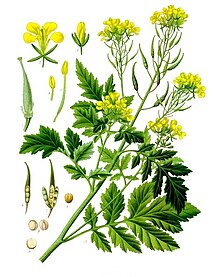White mustard
| White mustard | |
|---|---|

| |
| Scientific classification | |
| Kingdom: | Plantae |
| Clade: | Tracheophytes |
| Clade: | Angiosperms |
| Clade: | Eudicots |
| Clade: | Rosids |
| Order: | Brassicales |
| Family: | Brassicaceae |
| Genus: | Sinapis |
| Species: | S. alba
|
| Binomial name | |
| Sinapis alba | |
| Synonyms | |
| |

White mustard (Sinapis alba) is an annual plant of the family Brassicaceae. It is sometimes also referred to as Brassica alba or B. hirta. Grown for its seeds, it is used to make the condiment mustard, as a fodder crop, or as a green manure. It is now widespread worldwide, although it probably originated in the Mediterranean region.
Description
[edit]White mustard is an annual, growing to 70 centimetres (28 in) high with stalkless pinnate leaves, similar to Sinapis arvensis.[1]
Distribution
[edit]Most common in Europe, North Africa, the Middle East and Central Asia, it can be found worldwide. It has been found as far north as Greenland,[2] and naturalized throughout Great Britain and Ireland.[3]
Culinary uses
[edit]The yellow flowers of the plant produce glabrous or sparsely bristled seed pods. Each fruit (silique) contains roughly a half dozen seeds. The plants are harvested for their seeds just prior to the seed pods becoming ripe and bursting open (dehiscing).
White mustard seeds are hard spheroid seeds, usually around 1.0 to 1.5 mm (0.039 to 0.059 in) in diameter,[4] with a color ranging from beige or yellow to light brown. They can be used whole for pickling or toasted for use in dishes. When ground and mixed with other ingredients, a paste or more standard condiment can be produced. Sinapis alba is used to make the commonplace yellow table mustard, with additional yellow coloring provided by turmeric in some formulations.
The seeds contain sinalbin, which is a thioglycoside responsible for their pungent taste. In Sinapis alba, the glucosinolate sinalbin is broken down by enzymes like myrosinase, resulting in the formation of 'white principles.' These white principles consist of p-hydroxy benzyl isothiocyanate and p-hydroxy benzylamine.[5] White mustard has fewer volatile oils than black mustard seeds, and the flavor is considered to be milder.[6][7]
In Greece, the plant's leaves are eaten during the winter, before it blooms. Greeks call it vrouves (βρούβα) or lapsana (λαψάνα). The blooming season of this plant (February–March) is celebrated with the Mustard Festival, a series of festivities in the wine country of California (Napa and Sonoma Counties).[citation needed]
Other uses
[edit]White mustard is commonly used as a cover and green manure crop in Europe (between the UK and Ukraine). A large number of varieties exist,[8][9] mainly differing in lateness of flowering and resistance against white beet-cyst nematode (Heterodera schachtii). Farmers generally prefer late-flowering varieties that do not produce seeds which may develop into weeds in the subsequent year's crop rotation. Early vigor is important to cover the soil quickly to suppress weeds and protect the soil against erosion. In rotations with sugar beets, suppression of the sugar beet nematode (SBCN) is an important trait. Since white mustard is a SBCN-resistant crop, it is able to reduce nematode populations by preventing growth of young nematodes.[10]
Gallery
[edit]-
flowering plant
-
plant
-
flowers
-
seed pods
-
cover crop
See also
[edit]References
[edit]- ^ Webb, D.A., Parnell, J. and Doogue, D. 1996. An Irish Flora. Dundalgan Press Ltd., Dundalk. ISBN 0-85221-131-7
- ^ Beesley, S. and Wilde, J. 1997. Urban Flora of Belfast. The Institute of Irish Studies and The Queen's University of Belfast. ISBN 0-85389-695-X.
- ^ Clapham, A.R., Tutin, T.G. and Warburg, E.F. 1968 Excursion Flora of the British Isles. Cambridge University Press. ISBN 0-521-04656-4
- ^ Balke, D. (2000). "Rapid aqueous extraction of mucilage from whole white mustard seed". Food Research International. 33 (5): 347–356. doi:10.1016/S0963-9969(00)00055-7.
- ^ Peter, K. V., ed. (2012). Handbook of herbs and spices. Vol. 2. Woodhead Publishing series in food science, technology and nutrition. Vol. 2 (2 ed.). Oxford: Woodhead Publ. ISBN 978-0-85709-568-8.
- ^ Tan, S. H. (2011). "Extraction and residual antinutritional components in protein fractions of Sinapis alba and Brassica napus oil-free meals". 17th Australian Research Assembly on Brassicas (ARAB). Wagga Wagga, NSW: 107.
- ^ Garland, S. (1993). The Complete Book of Herbs & Spices: An Illustrated Guide to Growing and Using Culinary, Aromatic, Cosmetic and Medicinal Plants. Frances Lincoln Limited, Rydalmere, NSW, Australia. ISBN 978-0340584699.
- ^ Germany
- ^ Netherlands
- ^ Hafez, Saad (1998). "Sugar Beet Nematodes in Idaho and Eastern Oregon" (PDF). University of Idaho.
External links
[edit]- Sinapis alba Flowers in Israel
- Sinapis alba in the CalPhotos photo database, University of California, Berkeley
- "Sinapis alba". Calflora. Berkeley, California: The Calflora Database.
- "Sinapis alba". Plants for a Future.
- http://www.maltawildplants.com/CRUC/Sinapis_alba.php Comprehensive profile for Sinapis alba.





